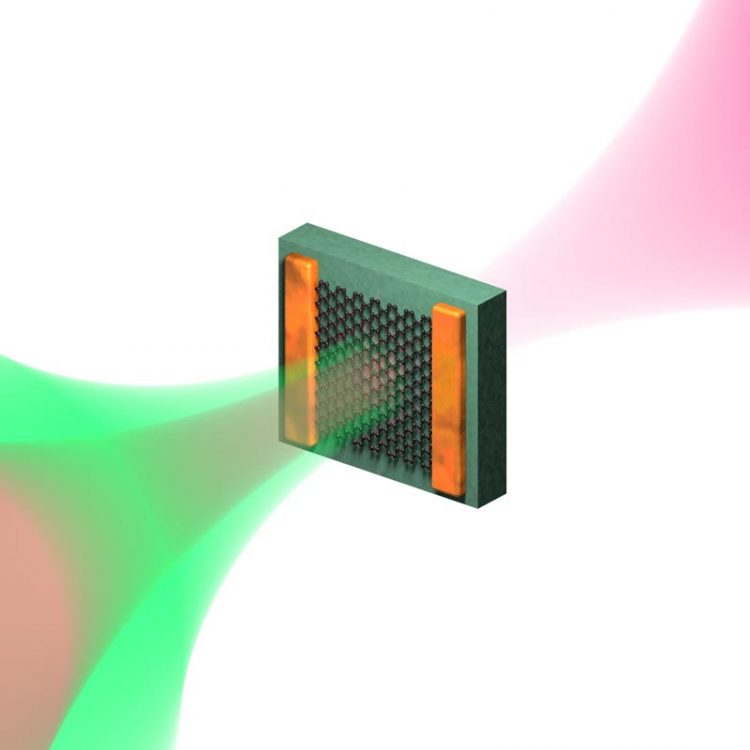Photoexcited graphene puzzle solved

Schematic representation of the ultrafast optical pump – terahertz probe experiment, where the optical pump induces electron heating and the terahertz pulse is sensitive to the conductivity of graphene directly after this heating process Ill./©: Fabien Vialla
Light detection and control lies at the heart of many modern device applications, such as smartphone cameras. Using graphene as a light-sensitive material for light detectors can offer significant improvements with respect to materials being used nowadays.
For example, graphene can detect light of almost any color, and it gives an extremely fast electronic response within one millionth of a millionth of a second. Thus, in order to properly design graphene-based light detectors it is crucial to understand the processes that take place inside the graphene after it absorbs light.
The Mainz-based researchers Dr. Hai Wang, Professor Dmitry Turchinovich, Professor Mathias Kläui, and Professor Mischa Bonn, in collaboration with scientists from various European labs, have now succeeded in understanding these processes. The project was led by Dr. Klaas-Jan Tielrooij from ICFO in Spain, who was recently elected visiting professor at the Materials Science in Mainz (MAINZ) Graduate School of Excellence.
Published recently in Science Advances, their work gives a thorough explanation of why the graphene conductivity in some cases increases after light absorption while it decreases in others. The researchers were able to show that this behavior correlates with the way in which the energy from the absorbed light flows to the graphene electrons: After light is absorbed by the graphene, the processes through which graphene electrons heat up happen extremely fast and with a very high efficiency.
For highly doped graphene with many free electrons present, ultrafast electron heating leads to carriers with elevated energy, so-called hot carriers. This, in turn, leads to a decrease in conductivity.
Interestingly enough, for weakly doped graphene with less free electrons, electron heating leads to the creation of additional free electrons and, thus, an increase in conductivity. These additional carriers are the direct result of the gapless nature of graphene. In gapped materials, electron heating does not lead to additional free carriers.
This simple scenario of light-induced electron heating in graphene can explain many observed effects. Aside from describing the conductive properties of the material after light absorption, it can explain carrier multiplication, where under specific conditions one absorbed light particle, i.e., a photon, can indirectly generate more than one additional free electron and thus create an efficient photo response within a device.
The results of the paper and, in particular, understanding electron heating processes accurately, will definitely mean a great boost in the design and development of graphene-based light detection technology.
This research work was funded by the German Research Foundation and by the European Commission under Graphene Flagship as well as by a Mineco Young Investigator grant.
Image:
http://www.uni-mainz.de/bilder_presse/08_physik_komet_graphen_lichtsensor.jpg
Schematic representation of the ultrafast optical pump – terahertz probe experiment, where the optical pump induces electron heating and the terahertz pulse is sensitive to the conductivity of graphene directly after this heating process
Ill./©: Fabien Vialla
Publication:
Andrea Tomadin et al.
The ultrafast dynamics and conductivity of photoexcited graphene at different Fermi energies
Science Advances, 11 May 2018
DOI: 10.1126/sciadv.aar5313
http://advances.sciencemag.org/content/4/5/eaar5313.full
Contact:
Dr. Hai I. Wang
Max Planck Institute for Polymer Research
55128 Mainz, GERMANY
phone +49 6131 379-522
e-mail: wanghai@mpip-mainz.mpg.de
http://www.mpip-mainz.mpg.de/5111004/dr-hai-wang
Professor Dr. Mathias Kläui
Condensed Matter Physics
Institute of Physics
Johannes Gutenberg University Mainz
55099 Mainz, GERMANY
phone +49 6131 39-23633
e-mail: klaeui@uni-mainz.de
https://www.klaeui-lab.physik.uni-mainz.de/homepage-prof-dr-mathias-klaeui/
Related links:
https://www.klaeui-lab.physik.uni-mainz.de/ – Kläui Lab at the JGU Institute of Physics
https://www.klaeui-lab.physik.uni-mainz.de/magnetic-and-electronic-properties-of… – Research project on Magnetic and electronic properties of carbon allotropes at the JGU Institute of Physics
https://www.blogs.uni-mainz.de/fb08-iph-eng/ – JGU Institute of Physics
http://www.mpip-mainz.mpg.de/home/en – Max Planck Institute for Polymer Research
http://www.mainz.uni-mainz.de/ – Graduate School of Excellence Materials Science in Mainz (MAINZ)
Read more:
http://www.uni-mainz.de/presse/aktuell/4356_ENG_HTML.php – press release ” Construction set of magnon logic extended: Magnon spin currents can be controlled via spin valve structure” (14 March 2018)
Media Contact
All latest news from the category: Physics and Astronomy
This area deals with the fundamental laws and building blocks of nature and how they interact, the properties and the behavior of matter, and research into space and time and their structures.
innovations-report provides in-depth reports and articles on subjects such as astrophysics, laser technologies, nuclear, quantum, particle and solid-state physics, nanotechnologies, planetary research and findings (Mars, Venus) and developments related to the Hubble Telescope.
Newest articles

Security vulnerability in browser interface
… allows computer access via graphics card. Researchers at Graz University of Technology were successful with three different side-channel attacks on graphics cards via the WebGPU browser interface. The attacks…

A closer look at mechanochemistry
Ferdi Schüth and his team at the Max Planck Institut für Kohlenforschung in Mülheim/Germany have been studying the phenomena of mechanochemistry for several years. But what actually happens at the…

Severe Vulnerabilities Discovered in Software to Protect Internet Routing
A research team from the National Research Center for Applied Cybersecurity ATHENE led by Prof. Dr. Haya Schulmann has uncovered 18 vulnerabilities in crucial software components of Resource Public Key…





















